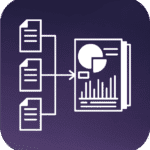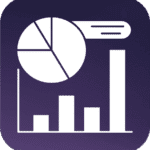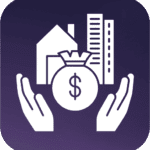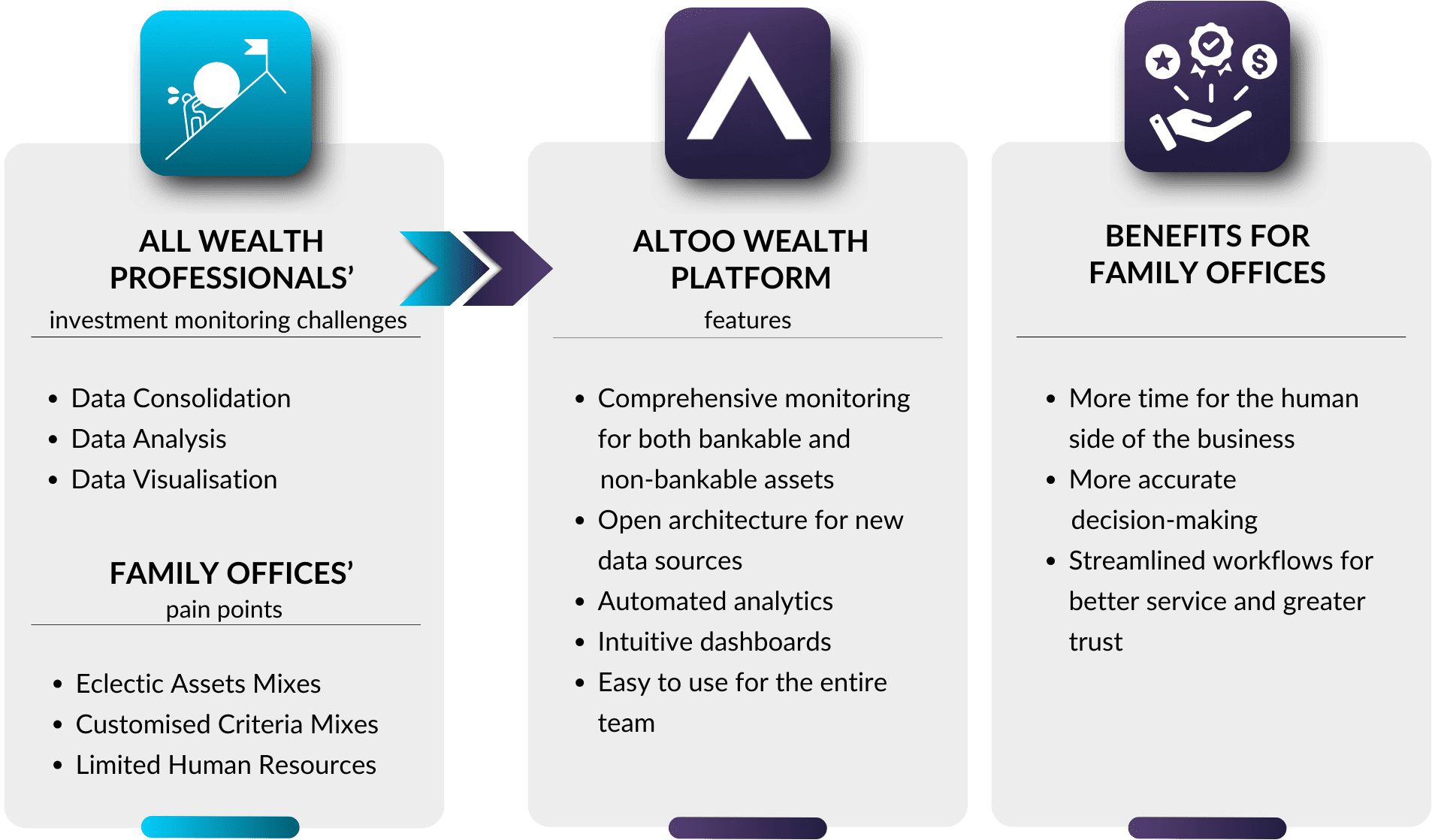These days, investors want to make data-driven decisions. Depending on their net worth and financial goals, they may seek support for these decisions from a wide variety of sources, from family officers like you to self-service robo-advisor platforms. As a result, across the entire industry it is more important than ever to pay attention to how investments are made and monitored, specifically with respect to the challenges of:
Data consolidation

Data consolidation
Asset data comes in many formats from an expanding array of sources. To gain the best analytical insights from whatever data you have available, you must bring it all together to create a foundation for analysis. A well engineered digital wealth platform can help here by automatically pulling data from various sources, unifying it, and eliminating the need to manually copy-paste information from spreadsheets and quarterly reports, for example.
Data analysis

Data analysis
Investments must be monitored according to criteria reflecting the investor’s goals. For traditional asset types like equities, there are well-known criteria like price performance vs overall market performance. For alternative asset types like real estate or private equity, however, more specialised criteria will likely need to be applied. Again, a digital wealth platform can come to the rescue by handling complex calculations and weighing up data in a fraction of the time it would take you otherwise.
Data visualisation

Data visualisation
If not easily understandable, analytical results will not be of much use to investment decision-makers. Visual representations help investors act on complex data insights. However, manually creating such visualisations can often be tedious and time consuming. A digital wealth platform can also handle this aspect of investment by automatically translating analysis into dashboards, charts, and graphs that are easy on the human eye.
As a family officer rising to these data-driven investment monitoring challenges while building a multi-generational legacy, you have three related major challenges:
01 Monitoring an Eclectic Asset Mix

01 Monitoring an Eclectic Asset Mix
Based on 2023 research from Goldman Sachs,1 the family you serve likely expects you to monitor about twice as many alternative assets (44% versus ~20% of portfolio allocation) as would an ultra-high net worth individual. And over a third of family offices invest in collectibles like art and wine.
Families with such a diverse universe of assets are justified in questioning if and how you are keeping track of everything. According to the Global Head of Denton’s Family Office and HNW Group, one recurring concern in family office discussions is the potential for information to be treated in silos. In this respect, putting family members’ minds at ease hinges on effective data consolidation and presentation.
With a digital wealth platform supporting application programming interfaces (APIs), data on family assets custodied at multiple financial institutions can be fairly straightforward to bring together. APIs provide gateways for asset data to flow from these multiple sources into the platform. APIs are becoming increasingly popular across the wealth management industry, with 63% of executives rapidly expanding their use.2
Data on assets like art and directly held businesses tends to be far less standardised and more complex to handle versus data coming from institutions. Therefore, tracking non-bankable assets is rarely a primary feature of wealth management software.
The Altoo Wealth Platform, however, was designed specifically with family offices in mind. It allows you track a wide range of bankable and non-bankable assets using data from multiple sources spanning the family’s entire portfolio.
“We frequently observe families where the original details of past investments are not available. Collectibles stored across different locations can be particularly tricky to keep track of, for example. Naturally, there is some scepticism that their family office can keep these details organised when they cannot. Those doubts quickly disappear after the family sees the Altoo dashboards. Everything is there visible in one place, even that ‘forgotten’ artwork that has been in storage for a decade,” explains Ian Keates, the CEO of the Swiss fintech Altoo AG.
02 Monitoring Investments According to a Highly Customised Criteria Mix

02 Monitoring Investments According to a Highly Customised Criteria Mix
All investors care about asset performance. Not all investors, however, incorporate succession planning, family values, or legacy goals into their decision-making processes. Additionally, family members often hold divergent views on what defines a good investment. For example, 2022 research from Stanford3 found that 80% of Millenials are potentially willing to sacrifice financial gains to make eco-conscious investments versus only 35% of Baby Boomers.
Monitoring investments based on such a wide array of often subjective factors necessitates empathetic human judgement which technology alone cannot provide.
Technology can, on the other hand, free up your mind to focus on building relationships with family members, understanding the human side of their challenges, and finding creative solutions. PwC has identified automation of routine, otherwise time-consuming tasks like gathering and analysing as family offices’ most valuable benefit of emerging technologies.
The Altoo Wealth Platform is the perfect example of such a digital tool. You can rely on it to do the heavy lifting when it comes to the quantifiable aspects of the family’s portfolio – like measuring financial performance and portfolio allocation statistics – so you can focus on addressing the unquantifiable ones.
“I’m always impressed at the diverse skill sets family officers have. From finance to psychology and even diplomacy, it seems like they have to do a little bit of everything. Here at Altoo, one of our primary goals is to take the automatable things off their plate so they can excel at the things only they can do,” says Simon Kaufmann, Head of Business Development at Altoo AG.
03 Limited Human Resources

03 Limited Human Resources
Your family office exists to serve family members with levels of personalisation and discretion that are simply unavailable anywhere else. Your team is therefore relatively tight knit and likely does not include armies of researchers, analysts, or – based on 2022 research from BlackRock4 – IT professionals in particular. Of the family offices BlackRock surveyed, 50% recognised some gaps when it came to sourcing technology expertise.
Regardless of how many team members you have, their time is valuable. They cannot afford to spend it on repetitive tasks like data entry and number crunching. As outlined above, a sophisticated digital wealth platform can handle many such routine aspects of investment monitoring.
Remember, however, that every technology solution takes time to learn and operate. When selecting one, you should aim to minimise this time for your team. According to the Harvard Business Review, IT infrastructure that is not supportive and user-friendly is likely to disappoint when it comes to actually driving value for your firm.3
The Altoo Wealth Platform was built to help you and your team begin delivering more value in a matter of days – and you can rely on our Wealth Servicing Team to ensure that you do.
“Every family office’s requirements and workflows are different, but as a rule of thumb we can get the entire team up and running with Altoo in five business days. Once everyone sees how it makes their lives easier when it comes to handling data, finding documentation, and so forth, they are quite happy to keep using it every day. One family officer has even told me that she can’t imagine her job without it now,” adds Simon Kaufmann, Head of Business Development at Altoo AG.
Make Technology Your Strong Point
What makes a technology platform the right choice for overcoming these challenges? Ideally, it will have:
- open architecture that allows links to new sources and types of data as they become available,
- the ability to automate asset performance analysis according to objective financial criteria so you can focus on exploring more subjective ones,
- data visualisation capabilities that present analytical findings in clear dashboards that are understandable to family members regardless of their tech-savviness or financial literacy, and
- a user-friendly design that fits well with and supports your team’s unique workflows with a minimum of training and onboarding time.
The Altoo Wealth Platform has all of the above. Designed for intuitive use by family members and your team, it automatically consolidates and monitors data on all family wealth items – regardless of form or location – and presents findings in custom reports in attractive dashboards that ease your team’s work towards superior, trust-inspiring decisions.






